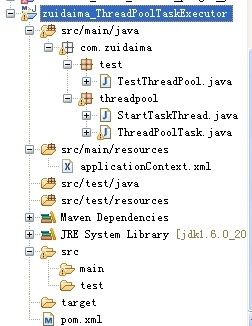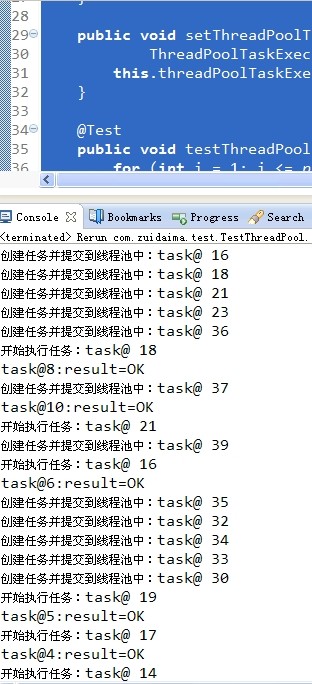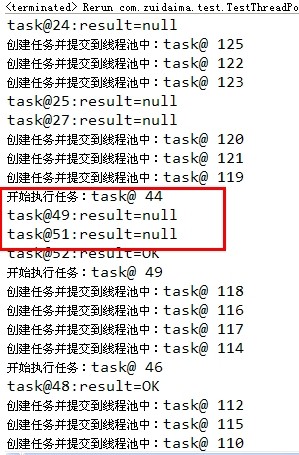用threadpoolexecutor的時候,又想知道被執(zhí)行的任務的執(zhí)行情況,這時就可以用futuretask。
threadpooltask
|
1
2
3
4
5
6
7
8
9
10
11
12
13
14
15
16
17
18
19
20
21
22
23
24
25
26
27
28
29
|
package com.paul.threadpool;import java.io.serializable;import java.util.concurrent.callable;public class threadpooltask implements callable<string>, serializable { private static final long serialversionuid = 0; // 保存任務所需要的數據 private object threadpooltaskdata; private static int consumetasksleeptime = 2000; public threadpooltask(object tasks) { this.threadpooltaskdata = tasks; } public synchronized string call() throws exception { // 處理一個任務,這里的處理方式太簡單了,僅僅是一個打印語句 system.out.println("開始執(zhí)行任務:" + threadpooltaskdata); string result = ""; // //便于觀察,等待一段時間 try {// long r = 5/0; for ( int i= 0 ; i< 100000000 ; i++){ } result = "ok"; } catch (exception e) { e.printstacktrace(); result = "error"; } threadpooltaskdata = null; return result; }} |
模擬客戶端提交的線程
|
1
2
3
4
5
6
7
8
9
10
11
12
13
14
15
16
17
18
19
20
21
22
23
24
25
26
27
28
29
30
31
32
33
34
35
|
package com.paul.threadpool;import java.util.concurrent.executionexception;import java.util.concurrent.futuretask;import org.springframework.scheduling.concurrent.threadpooltaskexecutor;public class starttaskthread implements runnable{ private threadpooltaskexecutor threadpooltaskexecutor; private int i; public starttaskthread(threadpooltaskexecutor threadpooltaskexecutor,int i) { this.threadpooltaskexecutor = threadpooltaskexecutor; this.i = i; } @override public synchronized void run() { string task = "task@ " + i; system.out.println("創(chuàng)建任務并提交到線程池中:" + task); futuretask<string> futuretask = new futuretask<string>( new threadpooltask(task)); threadpooltaskexecutor.execute(futuretask); // 在這里可以做別的任何事情 string result = null; try { // 取得結果,同時設置超時執(zhí)行時間為0.1秒。同樣可以用future.get(),不設置執(zhí)行超時時間取得結果 result = futuretask.get(); } catch (interruptedexception e) { futuretask.cancel(true); } catch (executionexception e) { futuretask.cancel(true); } catch (exception e) { futuretask.cancel(true); // 超時后,進行相應處理 } finally { system.out.println("task@" + i + ":result=" + result); }} |
spring配置文件
|
1
2
3
4
5
6
7
8
9
10
11
12
13
14
15
16
17
18
19
20
21
22
23
24
25
26
27
28
29
30
31
32
33
34
35
36
37
38
39
40
41
42
43
44
45
46
47
48
49
50
51
52
53
54
55
56
57
58
59
|
<?xml version="1.0" encoding="utf-8" ?><beans xmlns="http://www.springframework.org/schema/beans" xmlns:xsi="http://www.w3.org/2001/xmlschema-instance" xmlns:p="http://www.springframework.org/schema/p" xmlns:aop="http://www.springframework.org/schema/aop" xmlns:tx="http://www.springframework.org/schema/tx" xsi:schemalocation="http://www.springframework.org/schema/beans http://www.springframework.org/schema/beans/spring-beans-2.5.xsdhttp://www.springframework.org/schema/tx http://www.springframework.org/schema/tx/spring-tx-2.5.xsdhttp://www.springframework.org/schema/aop http://www.springframework.org/schema/aop/spring-aop-2.5.xsd"> <!-- 配置數據源 --> <bean id="datasource" class="org.apache.commons.dbcp.basicdatasource" destroy-method="close" p:driverclassname="com.mysql.jdbc.driver" p:url="jdbc:mysql://localhost:3306/mb_main?useunicode=true&characterencoding=utf-8&useserverprepstmts=true" p:username="root" p:password="1234" /> <!-- 配置jdbc模板 --> <bean id="jdbctemplate" class="org.springframework.jdbc.core.jdbctemplate" p:datasource-ref="datasource" /> <!-- 事務管理器 --> <bean id="transactionmanager" class="org.springframework.jdbc.datasource.datasourcetransactionmanager" p:datasource-ref="datasource" /> <tx:advice id="jdbctxadvice" transaction-manager="transactionmanager"> <tx:attributes> <tx:method name="*" /> </tx:attributes> </tx:advice> <!-- 使用aop/tx命名空間配置事務管理,這里對service包下的服務類方法提供事務 --> <aop:config> <aop:pointcut id="jdbcservicemethod" expression="within(com.baobaotao.service..*)" /> <aop:advisor pointcut-ref="jdbcservicemethod" advice-ref="jdbctxadvice" /> </aop:config> <!-- 配置dao <bean id="loginlogdao" class="com.baobaotao.dao.loginlogdao" p:jdbctemplate-ref="jdbctemplate" /> <bean id="userdao" class="com.baobaotao.dao.userdao" p:jdbctemplate-ref="jdbctemplate" /> <bean id="userservice" class="com.baobaotao.service.userservice" p:userdao-ref="userdao" p:loginlogdao-ref="loginlogdao" /> --> <bean id="threadpooltaskexecutor" class="org.springframework.scheduling.concurrent.threadpooltaskexecutor"> <!-- 核心線程數,默認為1 --> <property name="corepoolsize" value="10" /> <!-- 最大線程數,默認為integer.max_value --> <property name="maxpoolsize" value="50" /> <!-- 隊列最大長度,一般需要設置值>=notifyscheduledmainexecutor.maxnum;默認為integer.max_value <property name="queuecapacity" value="1000" /> --> <!-- 線程池維護線程所允許的空閑時間,默認為60s --> <property name="keepaliveseconds" value="300" /> <!-- 線程池對拒絕任務(無線程可用)的處理策略,目前只支持abortpolicy、callerrunspolicy;默認為后者 --> <property name="rejectedexecutionhandler"> <!-- abortpolicy:直接拋出java.util.concurrent.rejectedexecutionexception異常 --> <!-- callerrunspolicy:主線程直接執(zhí)行該任務,執(zhí)行完之后嘗試添加下一個任務到線程池中,可以有效降低向線程池內添加任務的速度 --> <!-- discardoldestpolicy:拋棄舊的任務、暫不支持;會導致被丟棄的任務無法再次被執(zhí)行 --> <!-- discardpolicy:拋棄當前任務、暫不支持;會導致被丟棄的任務無法再次被執(zhí)行 --> <bean class="java.util.concurrent.threadpoolexecutor$callerrunspolicy" /> </property> </bean></beans> |
測試類
|
1
2
3
4
5
6
7
8
9
10
11
12
13
14
15
16
17
18
19
20
21
22
23
24
25
26
27
28
29
30
31
32
33
34
35
36
37
38
39
|
package com.paul.threadpool;import java.util.concurrent.arrayblockingqueue;import java.util.concurrent.threadpoolexecutor;import java.util.concurrent.timeunit;import org.junit.test;import org.springframework.beans.factory.annotation.autowired;import org.springframework.scheduling.concurrent.threadpooltaskexecutor;import org.springframework.test.context.contextconfiguration;import org.springframework.test.context.junit4.abstractjunit4springcontexttests;@contextconfigurationpublic class testthreadpool extends abstractjunit4springcontexttests{ private static int producetasksleeptime = 10; private static int producetaskmaxnumber = 1000; @autowired private threadpooltaskexecutor threadpooltaskexecutor; public threadpooltaskexecutor getthreadpooltaskexecutor() { return threadpooltaskexecutor; } public void setthreadpooltaskexecutor( threadpooltaskexecutor threadpooltaskexecutor) { this.threadpooltaskexecutor = threadpooltaskexecutor; } @test public void testthreadpoolexecutor() { // 構造一個線程池 final threadpoolexecutor threadpool = new threadpoolexecutor(2, 4, 600, timeunit.seconds, new arrayblockingqueue<runnable>(3), new threadpoolexecutor.callerrunspolicy()); for (int i = 1; i <= producetaskmaxnumber; i++) { try { thread.sleep(producetasksleeptime); } catch (interruptedexception e1) { e1.printstacktrace(); } new thread(new starttaskthread(threadpooltaskexecutor,i)).start(); } }} |
項目截圖(基于maven構建)

運行截圖:

如果遇到cpu忙執(zhí)行超過1秒的會返回null

總結
以上就是這篇文章的全部內容了,希望本文的內容對大家的學習或者工作具有一定的參考學習價值,謝謝大家對服務器之家的支持。如果你想了解更多相關內容請查看下面相關鏈接
原文鏈接:http://www.blogjava.net/paulwong/archive/2011/12/07/365773.html















